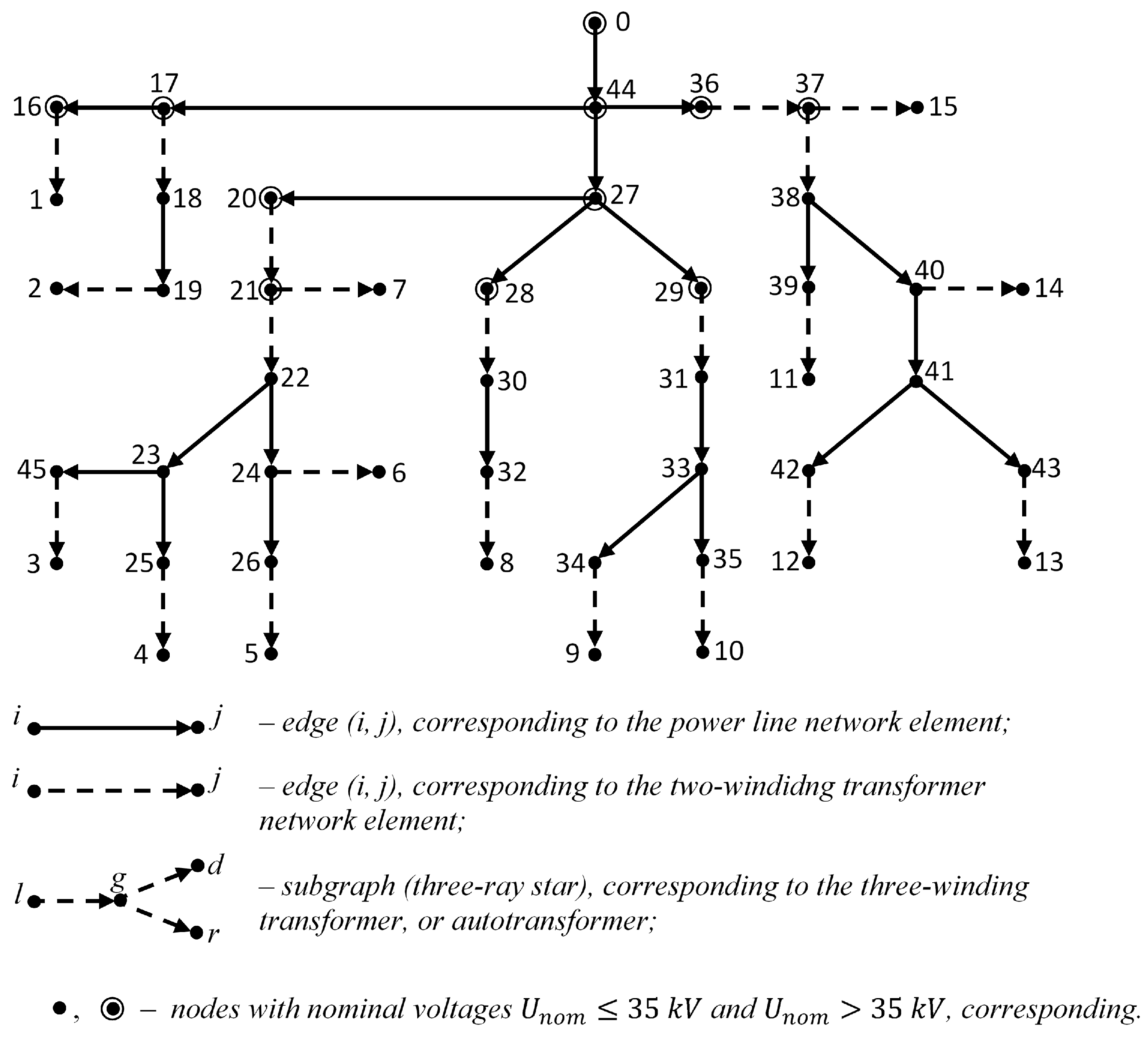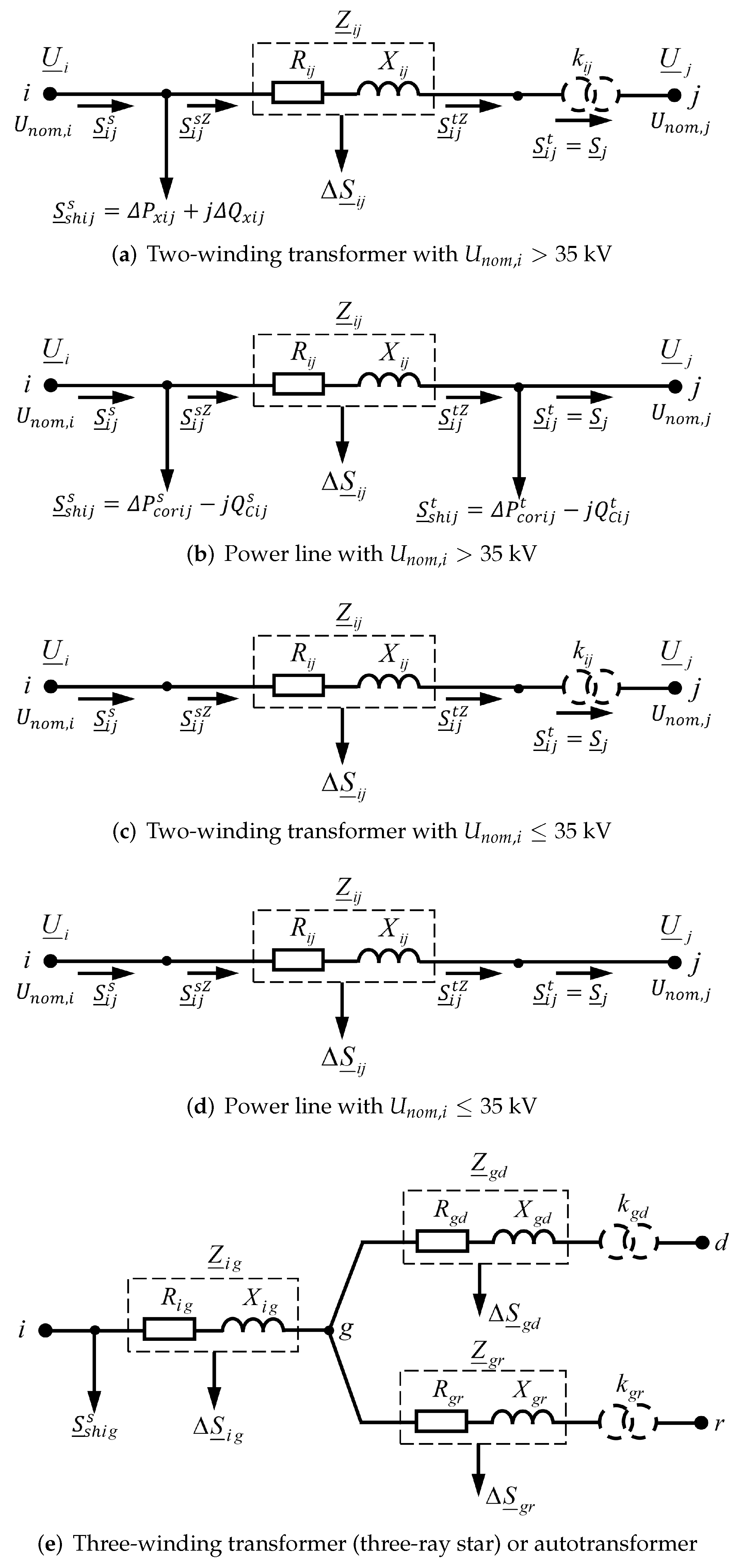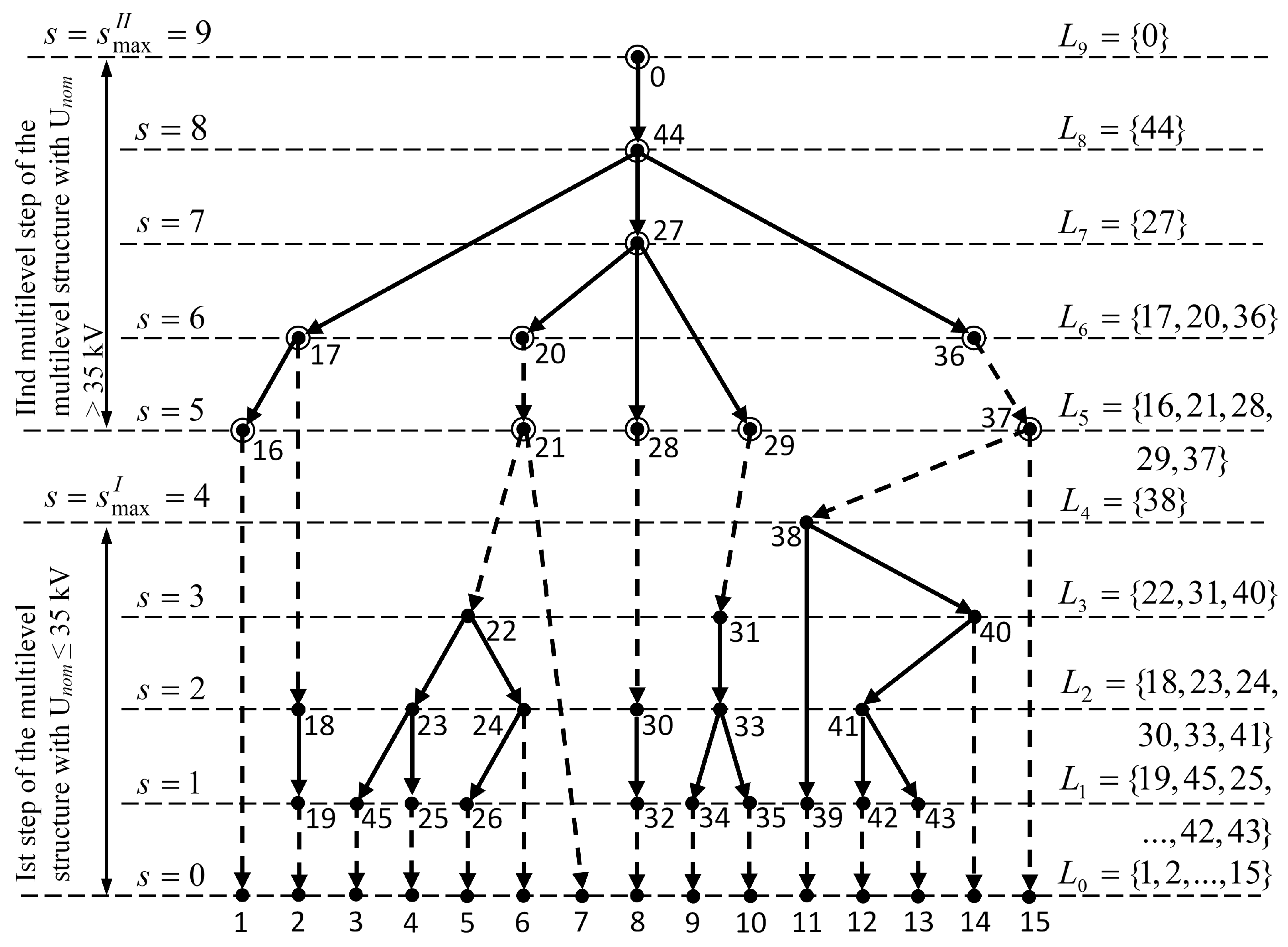Power Flows and Losses Calculation in Radial Networks by Representing the Network Topology in the Hierarchical Structure Form
Abstract
:1. Introduction
- Technological factor—it directly depends on the characteristic physical processes, and can change under the influence of the load component, conditionally fixed costs, as well as climatic conditions;
- Energy costs spent on the operation of auxiliary equipment and ensuring the necessary conditions for the work of technical personnel;
- Commercial losses—this category includes errors in metering devices, as well as other factors that cause the underestimation of electric energy.
- Element-by-element calculation of load electricity losses in distribution electric networks 6–20 kV;
- Calculation of power flows and losses of electricity in radial electrical networks of 35 kV and above, at given loads and voltage of the power source;
- Problems of designing a system for electrical distribution networks’ overhead lines wire breakage remote diagnostics.
2. Structural Network Model
- (a)
- Equivalent circuit of a two-winding transformer with kV;
- (b)
- Equivalent circuit of a power line with kV;
- (c)
- Equivalent circuit of a two-winding transformer with kV;
- (d)
- Equivalent circuit of a power line with kV;
- (e)
- Equivalent circuit of a three-winding transformer (three-ray star) or autotransformer, where corresponds the primary voltage winding; , —secondary voltage winding; g—inner node of a three-pointed star connecting the , , .
- All end sections of the network are double-winding transformers, the end nodes of which form a set of load nodes ;
- At sections (17, 18), (28, 30), (29, 31), two-winding communication transformers are installed between network lines of different rated voltage;
- Two three-winding communication transformers are installed between the lines of the network of different rated voltages: the first corresponds to a three-ray star from three sections (20, 21), (21, 7), (21, 22) with an internal node ; the second—to a three-rayed star, consisting of three sections (36, 37), (37, 15), (37, 38) with an internal node . Here, sections (20, 21), (36, 37) correspond to the primary windings, and sections (21, 7), (21, 22) and (37, 15), (37, 38)—to the secondary windings of a three-winding coupling transformer;
- Communication transformers divide the initial network graph into two subgraphs: a subgraph with a lower step of the rated voltage kV, whose nodes are shown as a point “⋅”; subgraph with the upper step of the rated voltage kV, which nodes are shown as a point with a circle.
3. Calculation Algorithm Formulation and Discussion
3.1. Description of a Structured Hierarchically Multilevel Approach to the Calculation of Power Flows and Losses of Electricity in Radial Networks with Different Rated Voltages
3.2. Representation of the Initial Network Graph in the Form of a Hierarchical Multilevel Structure with Two Steps of the Nominal Voltage
- Step 0.
- Calculate and form the set of vertices of the -th level of the hierarchy from the terminal vertices of the initial network graph, i.e., set;
- Step 1.
- Form the initial state of the sets , (where ):
- Step 2.
- Set the initial value of the step number of the nominal voltage: ;
- Step 3.
- Calculate the next step number: ;
- Step 4.
- Calculate the number of the next top level in the hierarchy: ;
- Step 5.
- If , then form a set of informationally secured vertices of the s-th hierarchy level of the multilevel structure first step with kV:
- Step 6.
- If , then form a set informationally secured vertices of the s-th hierarchy level of the second step of the multilevel structure with kV:
- Step 7.
- If , then calculate the new state of the sets , :where , .
- Step 8.
- If , then go to step 9, otherwise go to step 4.
- Step 9.
- If , then:
- Step 10.
- If , then:
- Step 11.
- If (or ), then go to step 3; otherwise, go to the block for calculating power flows and losses of electricity in the network, i.e., to step 12. The results of this algorithm are:
- Set of level numbers of the first multilevel structure level with kV;
- Set of level numbers of the second multilevel structure level with kV;
- The set of network graph vertices for each s-th hierarchy level: , .
3.3. Calculation of Power Flows and Losses of Electricity in Networks with Different Nominal Voltages
- Step 12.
- Set loads power and power source voltage denotes node voltage;
- Step 13.
- Calculate , and for the iteration take the voltage at the network nodes equal to the nominal:
- Step 14.
- Calculate the number of the next step of the iteration: .
- Step 15.
- Formulation of the computing process structure when calculating a network power flow with different nominal voltages:
- Formulation of the calculation structure for the iteration:
- Formulation of the calculation structure for the and the stop condition:where , denote, respectively, the lower and upper limits of changing the number of the hierarchy level s at the first stage (from bottom to top); , denote respectively, the lower and upper limits of the change in s at the second stage (from top to bottom); denotes the Boolean value to disable () and enable () of the computational module “from bottom to top” at the last cycle of the iteration k; denotes total power losses for different types of sections (see Figure 2 and Table 1).
- First stage.
- Calculation of flow distribution (module algorithm “from bottom to top”).
- Step 16.
- If , then go to step 17; otherwise, go to step 21.
- Step 17.
- Calculate the initial value of the hierarchy level number: .
- Step 18.
- Calculate the number of the next top level in the hierarchy: .
- Step 19.
- For each Section and each , calculate:
- Power losses in resistance of Section to calculate the total loss of electricity in the network;
- Power flow at the beginning of the resistance in Section for voltage calculation at the end of Section j in the second stage;
- Power flow at the beginning of Section to calculate the power flow of the node i;
- Power flow of the node i.
The above power flows, depending on the type of sites , are calculated as follows (see Figure 2 and Table 1):Using the obtained power flows ,,, calculate the power flows for each node : - Step 20.
- If , then go to step 18; otherwise, go to step 21.
- Second stage.
- Calculation of voltages in network nodes (module algorithm “from top to bottom”).
- Step 21.
- Calculate the initial hierarchy level number .
- Step 22.
- Calculate voltage and its module for the ending node j of every Section to calculate the flow distribution at the first stage of the next iteration, and phase :
- For the sections with double-winding transformers or for the sections with secondary windings of three-winding transformers:
- For the sections with overhead power lines or for the sections with primary windings of three-winding transformers:
- Step 23.
- Calculate the number of the next low level in the hierarchy: .
- Step 24.
- If , then go to step 22; otherwise, go to step 25.
- Step 25.
- If , then go to step 14; otherwise, go to step 26.
- Step 26.
- Calculate the total losses of power and electricity in the network:where denotes the time interval during which the voltage of the source and the power of the loads are constant, meaning that:
4. Conclusions
Author Contributions
Funding
Acknowledgments
Conflicts of Interest
References
- Chen, B.; Xiang, K.; Yang, L.; Su, Q.; Huang, D.; Huang, T. Theoretical Line Loss Calculation of Distribution Network Based on the Integrated Electricity and Line Loss Management System. In Proceedings of the 2018 China International Conference on Electricity Distribution (CICED), Tianjin, China, 17–19 September 2018; pp. 2531–2535. [Google Scholar] [CrossRef]
- Asanov, M.; Asanova, S.; Safaraliev, M.; Lyukhanov, E.; Tavlintsev, A.; Shelyug, S. Elementwise power losses calculation in complex distribution power networks represented by hierarchical-multilevel topology structure. Prz. Elektrotechniczny 2021, 11, 106–110. [Google Scholar] [CrossRef]
- Ghosh, S.; Sherpa, K.S. An Efficient Method for Load-Flow Solution of Radial Distribution Networks. Int. J. Electr. Comput. Eng. 2008, 2, 2094–2101. [Google Scholar]
- Aravindhababu, P.; Ganapathy, S.; Nayar, K. A novel technique for the analysis of radial distribution systems. Int. J. Electr. Power Energy Syst. 2001, 23, 167–171. [Google Scholar] [CrossRef]
- Wang, J.; Guo, Z.; Yu, J. Practical calculation method of theoretical line loss in 10 kv power distribution network based on Dscada. In Proceedings of the 2008 China International Conference on Electricity Distribution, Guangzhou, China, 10–13 December 2008; pp. 1–6. [Google Scholar] [CrossRef]
- Asanova, S.; Safaraliev, M.; Askarbek, N.; Semenenko, S.; Aktaev, E.; Kovaleva, A.; Lyukhanov, E.; Staymova, E. Calculation of power losses at given loads and source voltage in radial networks of 35 kV and above by hierarchical-multilevel structured topology representation. Prz. Elektrotechniczny 2021, 1, 15–20. [Google Scholar] [CrossRef]
- Moreira Rodrigues, C.E.; de Lima Tostes, M.E.; Holanda Bezerra, U.; Mota Soares, T.; de Matos, E.O.; Serra Soares Filho, L.; dos Santos Silva, E.C.; Ferreira Rendeiro, M.; da Silva Moura, C.J. Technical Loss Calculation in Distribution Grids Using Equivalent Minimum Order Networks and an Iterative Power Factor Correction Procedure. Energies 2021, 14, 646. [Google Scholar] [CrossRef]
- Queiroz, L.M.O.; Roselli, M.A.; Cavellucci, C.; Lyra, C. Energy Losses Estimation in Power Distribution Systems. IEEE Trans. Power Syst. 2012, 27, 1879–1887. [Google Scholar] [CrossRef]
- Pavičić, I.; Ivanković, I.; Župan, A.; Rubeša, R.; Rekić, M. Advanced Prediction of Technical Losses on Transmission Lines in Real Time. In Proceedings of the 2019 2nd International Colloquium on Smart Grid Metrology (SMAGRIMET), Split, Croatia, 9–12 April 2019; pp. 1–7. [Google Scholar] [CrossRef]
- Vempati, N.; Shoults, R.R.; Chen, M.S.; Schwobel, L. Simplified Feeder Modeling for Loadflow Calculations. IEEE Trans. Power Syst. 1987, 2, 168–174. [Google Scholar] [CrossRef]
- Pansini, A. Power Transmission and Distribution, 2nd ed.; River Publishers: New York, NY, USA, 2005; p. 414. [Google Scholar]
- Mahmoud, K.; Yorino, N.; Ahmed, A. Optimal Distributed Generation Allocation in Distribution Systems for Loss Minimization. IEEE Trans. Power Syst. 2016, 31, 960–969. [Google Scholar] [CrossRef]
- Hung, D.Q.; Mithulananthan, N.; Bansal, R.C. Analytical Expressions for DG Allocation in Primary Distribution Networks. IEEE Trans. Energy Convers. 2010, 25, 814–820. [Google Scholar] [CrossRef]
- Acharya, N.; Mahat, P.; Mithulananthan, N. An analytical approach for DG allocation in primary distribution network. Int. J. Electr. Power Energy Syst. 2006, 28, 669–678. [Google Scholar] [CrossRef]
- Kansal, S.; Kumar, V.; Tyagi, B. Optimal placement of different type of DG sources in distribution networks. Int. J. Electr. Power Energy Syst. 2013, 53, 752–760. [Google Scholar] [CrossRef]
- Murthy, V.; Kumar, A. Comparison of optimal DG allocation methods in radial distribution systems based on sensitivity approaches. Int. J. Electr. Power Energy Syst. 2013, 53, 450–467. [Google Scholar] [CrossRef]
- Kalambe, S.; Agnihotri, G. Loss minimization techniques used in distribution network: Bibliographical survey. Renew. Sustain. Energy Rev. 2014, 29, 184–200. [Google Scholar] [CrossRef]
- Jain, N.; Singh, S.N.; Srivastava, S.C. A Generalized Approach for DG Planning and Viability Analysis Under Market Scenario. IEEE Trans. Ind. Electron. 2013, 60, 5075–5085. [Google Scholar] [CrossRef]
- Vatani, M.; Alkaran, D.S.; Sanjari, M.J.; Gharehpetian, G.B. Multiple distributed generation units allocation in distribution network for loss reduction based on a combination of analytical and genetic algorithm methods. IET Gener. Transm. Distrib. 2016, 10, 66–72. [Google Scholar] [CrossRef]
- Begovic, M. Electrical Transmission Systems and Smart Grids, 1st ed.; Springer: New York, NY, USA, 2013; pp. VI, 326. [Google Scholar]
- Shahnia, F.; Arefi, A.; Ledwich, G. Electric Distribution Network Planning, 1st ed.; Springer: Singapore, 2013; pp. XVI, 381. [Google Scholar]
- Asanova, S.M.; Ahyoev, J.S.; Askarbek, N.; Suerkulov, S.M.; Asanova, D.U.; Safaraliev, M.K. Method for designing drop-of-wire recognition systems on sections of undistorted two-wire power transmission lines. In IOP Conference Series: Materials Science and Engineering; IOP Publishing: Bristol, UK, 2020; Volume 966, p. 012114. [Google Scholar] [CrossRef]



| Section Type Number (p) | Predicate Functions for Choosing the Equivalent Circuit and Calculation Formula for Each Section | Equivalent Schemes: Figure 2 | Operators for Calculating Power Flows and Voltages in the Network Nodes |
|---|---|---|---|
| 1 | (a) | ||
| 2 | (b) | ||
| 3 | (c) | ||
| 4 | (d) | ||
| 5 | (e), where , | ||
| 6 | (e), where , |
| Sets | Sets | |
|---|---|---|
| 1 | ||
| 2 | ||
| 3 | ||
| 4 | ||
| 5 | ||
| 6 | ||
| 7 | ||
| 8 | ||
| 9 | ||
| 10 | ||
| 11 | ||
| 12 | ||
| 13 | ||
| 14 | ||
| 15 | ||
| 16 | ||
| 17 | ||
| 18 | ||
| 19 | ||
| 20 | ||
| 21 | ||
| 22 | ||
| 23 | ||
| 24 | ||
| 25 | ||
| 26 | ||
| 27 | ||
| 28 | ||
| 29 | ||
| 30 | ||
| 31 |
Publisher’s Note: MDPI stays neutral with regard to jurisdictional claims in published maps and institutional affiliations. |
© 2022 by the authors. Licensee MDPI, Basel, Switzerland. This article is an open access article distributed under the terms and conditions of the Creative Commons Attribution (CC BY) license (https://creativecommons.org/licenses/by/4.0/).
Share and Cite
Gulakhmadov, A.; Asanova, S.; Asanova, D.; Safaraliev, M.; Tavlintsev, A.; Lyukhanov, E.; Semenenko, S.; Odinaev, I. Power Flows and Losses Calculation in Radial Networks by Representing the Network Topology in the Hierarchical Structure Form. Energies 2022, 15, 765. https://doi.org/10.3390/en15030765
Gulakhmadov A, Asanova S, Asanova D, Safaraliev M, Tavlintsev A, Lyukhanov E, Semenenko S, Odinaev I. Power Flows and Losses Calculation in Radial Networks by Representing the Network Topology in the Hierarchical Structure Form. Energies. 2022; 15(3):765. https://doi.org/10.3390/en15030765
Chicago/Turabian StyleGulakhmadov, Aminjon, Salima Asanova, Damira Asanova, Murodbek Safaraliev, Alexander Tavlintsev, Egor Lyukhanov, Sergey Semenenko, and Ismoil Odinaev. 2022. "Power Flows and Losses Calculation in Radial Networks by Representing the Network Topology in the Hierarchical Structure Form" Energies 15, no. 3: 765. https://doi.org/10.3390/en15030765
APA StyleGulakhmadov, A., Asanova, S., Asanova, D., Safaraliev, M., Tavlintsev, A., Lyukhanov, E., Semenenko, S., & Odinaev, I. (2022). Power Flows and Losses Calculation in Radial Networks by Representing the Network Topology in the Hierarchical Structure Form. Energies, 15(3), 765. https://doi.org/10.3390/en15030765









